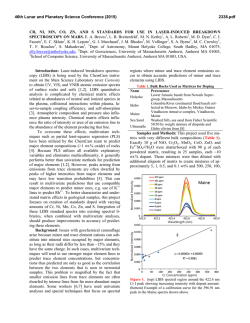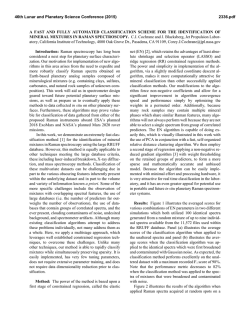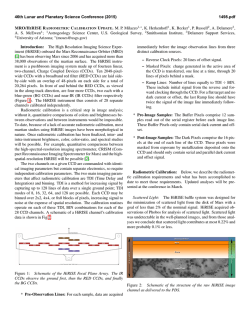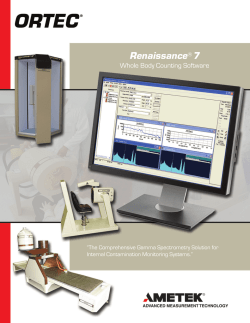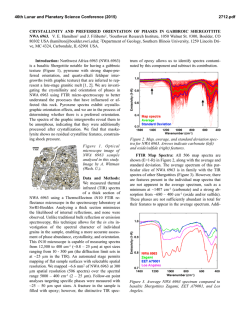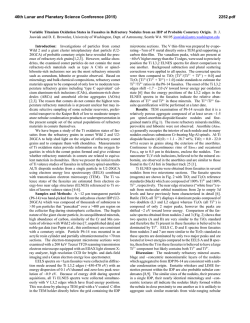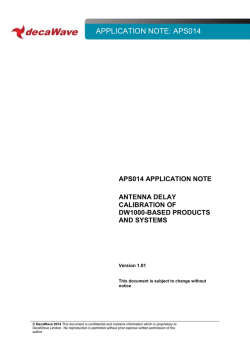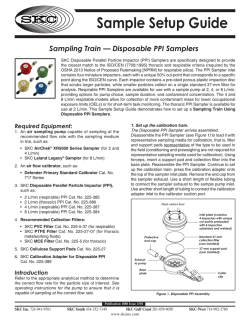
ANALYST - ResearchGate
R. Fernández-Ruiz,*a J. P. Cabañero,a E. Hernándezb and M. Leónc Servicio Interdepartamental de Investigación, Facultad de Ciencias, Universidad Autónoma de Madrid, Cantoblanco, E-28049 Madrid, Spain. E-mail: [email protected] b Departamento de Física, Fac. Exp. de Ciencias, Universidad del Zulia, Apdo. 526, Maracaibo, Venezuela c Departamento de Física Aplicada, Facultad de Ciencias, Universidad Autónoma de Madrid, Cantoblanco, E-28049 Madrid, Spain a FULL PAPER THE ANALYST Determination of the stoichiometry of CuxInySez by total-reflection XRF www.rsc.org/analyst Received 21st May 2001, Accepted 20th July 2001 First published as an Advance Article on the web 25th September 2001 A rapid and accurate total-reflection XRF method was developed in order to determine the absolute stoichiometry of ternary compounds of the type Cu+In+Se. The method was used to determine the composition of the synthesised compounds CuxInySez(CIS). Three compounds were synthesised with different atomic proportions x+y+z; 1+3+5, 2+4+7 and the no stoichiometric phase 1+2.5+4.75. The results obtained showed a systematic deficiency of In and an increment of Se with respect to the stoichiometric formula. Introduction Experimental CuInSe2 and related chalcopyrites have proved their suitability for use in high efficiency photovoltaic devices.1 Several authors2–4 have reported that deviation from ideal stoichiometry in this material produces secondary phases that segregate at the surface of the thin films. These phases have been identified as CuIn2Se3.5 and CuIn3Se5 in In-rich thin films. It is now believed that CuIn3Se5 plays a useful role5 in the operation and optimisation of CuInSe2-based solar cell devices. Since CuInSe2 and CuIn3Se5 layers show good p- and n-type conduction, a p-n junction can be formed at the interface between them. Thus, CuIn3Se5 has attracted much interest as a key compound for high conversion efficiency solar cells. However, the growth of CuIn3Se5 single crystals with a controlled stoichiometry is difficult due to the wide range of compositions in the Cu2Se– In2Se3 pseudo-binary system. Hence, an accurate control of composition is mandatory. Total-reflection X-ray fluorescence (TXRF) is a widely accepted technique. Prange6 and Tölg and R. Klockenkämper7 have reported the general characteristics of the technique, its potential applications, as well as a comparison of TXRF in relation to other contemporary analytical techniques. In previous work, Fernández-Ruiz et al.8 showed that the direct analysis of solid samples by TXRF without chemical manipulation is a powerful technique. This technique can be applied to study the mass relationships in Cu+In+Se matrices. In this paper a rapid and accurate method involving the analysis of solid samples by TXRF to determine the absolute stoichiometry of ternary compounds of the type Cu+In+Se is described. The stoichiometric composition of the compounds should be considered in principle as CuxInySez. Our objective was to evaluate the atomic substitutions x = 1 or 2, y and z, in order to explain the physical and chemical properties of these materials. For this study, we only need to know the mass relationship among the constituent elements. TXRF allows one to quantify these relationships readily, obtaining RSDs around 2% for In and 4% for Cu. Instrumentation DOI: 10.1039/b104466b The analysis by TXRF was performed using a Seifert EXTRAII spectrometer (Rich Seifer, Ahrensburg, Germany), equipped with two X-ray fine focus lines, with anodes of Mo and W, and a Si(Li) detector with an active area of 80 mm2 and a resolution of 157 eV at 5.9 keV (Mn Ka). Quasi-elastic light scattering spectroscopy (QELS) was used for the determination of the particle size distribution in suspensions of the analysed samples. The QELS system used was the AutoSizer IIc (Malvern Instruments, Malvern, Worcestershire, UK), equipped with a 5 mW He–Ne laser, a photomultiplier and a processing electronic system controlled by the Malvern AutoSizer computer package. To carry out the analysis, a source of Mo X-rays was used. The X-ray beam was filtered with a 50 mm Mo film. The samples were analysed in the range 0–20 keV. The relationships between the atomic efficiency factors were suitable for the analysis. In order to obtain a count rate of about 5000 counts s21 in all the measurements a 50 kV potential and a variable intensity between 5 and 25 mA was used as excitation conditions. Detection limits The detection limits (DL) associated with the evaluated elements, Cu, In and Se, were calculated according to Prange6 using, DL = 3M A B t (1) where M is the evaluated element mass, A and B are the areas of the peak and background associated with each element, respectively, and t is the acquisition time, according to the IUPAC definition. Analyst, 2001, 126, 1797–1799 This journal is © The Royal Society of Chemistry 2001 1797 For the experimental determination of the detection limits, ICP-AAS single element patterns of well-known concentration (Merck, Darmstadt, Germany) were used. A 20 3 1029 g amount of one element was deposited on a carrier sample and its spectrum was acquired for 1000 s with a dead time of 30% . The detection limits obtained were as follows, DLCu = 0.5 3 10212 g, DLIn = 8 3 10212 g and DLSe = 0.5 3 10212 g. The value of the efficiency factor of Co (xCo) was set to 1.00. The concentrations of the evaluated elements (Cx) were those obtained previously. Table 1 shows the sensitivity factors and the standard deviations (n = 5) obtained for each of the elements. Under these calibration conditions, Cu, Se and In were determined in the problem samples. Efficiency calibration curve Synthesis of CuxInySez samples Samples were ground to particle sizes under 10 mm, in order to make it unnecessary8 for matrix correction in TXRF. On the other hand, it is necessary to know the efficiency calibration curve associated with the experimental system, to quantify a problem sample. The efficiency calibration curve, i.e., relative fluorescence intensity vs. atomic number, is one of the most important and critical aspects to obtain a correct quantification by TXRF. The efficiency calibration curve, once established, stays invariable, provided that no geometric element of the system is modified. To accomplish the sensitivity calibration of the elements Cu, Se and In, (Z = 29, 34 and 49), ICP-AAS single element patterns of well-known concentration (Merck) were used, with the following certified concentrations, C(Cu) = 1006 ± 2 mg L21, C(Se) = 1010 ± 10 mg L21 and C(In) = 994 ± 2 mg L21. As reference element Co was used, concentration C(Co) = 997 ± 2 mg L21. One millilitre of each standard was taken and diluted with 100 mL of 5% v/v aqueous nitric acid (ultrapure water, Milli-Q, 18.2 MW), to stabilize the ions. The obtained concentrations of each element were C(Cu) = 10.06 ± 0.03 mg L21, C(Se) = 10.1 ± 0.1 mg L21, C(In) = 9.94 ± 0.03 mg L21 and C(Co) = 9.97 ± 0.03 mg L21. Five aliquots of 2 3 1026 L of the solutions were deposited on five carrier samples. The solvent was evaporated on a ceramic plate at 50 °C in a Class A-100 laminar flow chamber. The five preparations were analysed in the 0–20 keV energy region, with an acquisition time of 1000 s and a dead time of 30%. Fig. 1 represents one of the spectra obtained from the standards used. The deconvolution and integration of the observed lines was accomplished with the computer package AN-1000 (Oxford Instruments, High Wycombe, Buckinghamshire, UK). The following transitions were evaluated: K lines of Co, K lines of Cu, K lines of Se and L lines of In. For the calculation of the sensitivity factors, eqn. (2) was applied, where x is the atomic efficiency factor, C is the concentration of each element and A is the integrated area The single crystals were grown by using Cu, In and Se of 5N purity weighed in stoichiometric ratios. The mixture was sealed in an evacuated quartz tube. The sealed tube was placed in a vertical furnace and the temperature was initially raised to 300 °C at a rate of 10 °C h21. The ampoule was kept at this temperature for 12 h and then heated to 1150 °C at a rate of 50 °C h21. The mixture was maintained at this temperature for a period of 48 h. It was then cooled to room temperature at a rate of 5 °C h21. The ingot showed voids and porosity. Under these conditions three samples were prepared with molar ratios of 1+3+5, 2+4+7 and 1+2.5+2.75. ÈC x ˘ A x x = Í Co Co ˙ x Î Cx ˚ ACo (2) Fig. 1 Spectra obtained for the multi-pattern of Cu, Se, In and Co used in the sensitivity calibration. 1798 Analyst, 2001, 126, 1797–1799 Preparation of CuxInySez samples for TXRF analysis First, 10 mg of sample were ground in an agate mortar to a particle size of less than 30 mm. The sample was then ground again for a further 20 min by using a vibration micro-pulveriser (Fritsch, Oberstein, Germany), equipped with a ball and base made of agate. Afterwards, 1 mL of high-purity water was added. Next, the mixture was poured into a test-tube to which high-purity water was added up to a volume of 2 mL. The sample was homogenised for 10 min by ultrasonic desegregation in order to disperse possible agglomeration of particles. Finally, the particle size distribution in the suspension was checked by using QELS until it had the required distribution, less than 10 mm8 (Fig. 2). When the sample had this size distribution, it was again homogenised. Table 1 Efficiency factors and standard deviations (n = 5) obtained for each one of the elements studied Element x s RSD (%) Cu In Se 1.46 0.091 2.47 0.06 0.002 0.07 4 2 3 Fig. 2 QELS spectra obtained for the average particle size distribution in the analysed samples. Table 2 Stoichiometric results and standard deviations (n = 5) obtained for the three materials analysed Sample m(Cu) m(In) m(Se) Cu (at.-%) In (at.-%) Se (at.-%) x Cu y In z Se CuIn3Se5 Cu2In4Se7 CuIn2.5Se4.75 100.00 100.00 100.00 486.85 309.06 483.40 654.96 453.03 676.71 11.15 15.73 10.96 58.79 57.36 59.71 1.00 ± 0.04 2.00 ± 0.08 1.00 ± 0.04 2.69 ± 0.05 3.42 ± 0.07 2.68 ± 0.05 5.27 ± 0.2 7.29 ± 0.2 5.45 ± 0.2 30.05 26.91 29.33 Conclusion The developed TXRF methodology allows one to quantify the Cu, In and Se stoichiometry in CIS-related compounds with high precision. A standard deviation in the stoichiometric coefficients between 0.04 for Cu and 0.2 for Se was achieved. The method requires very small amounts of sample; a few milligrams are sufficient to obtain a repeatability between 2 and 4%. The method does not require any chemical manipulation. The simplicity, rapidity (30 min per sample) and low cost of the analysis make TXRF a suitable technique for monitoring the stoichiometric coefficients in this type of compound. Fig. 3 Comparative spectra of the three CIS materials evaluated. Results Analysis of CuxInySez stoichiometry After preparation of the samples, 5 mL of the suspensions were taken and placed on a flat carrier and the water was evaporated under vacuum. The following XRF transitions were evaluated: Cu K, In L and Se K. The Cu K line was used as reference with a value of 100 relative mass units. The Cu K line was chosen as reference due to its high definition in the spectrum and the absence of interferences from other signals. Fig. 3 shows the comparative spectra of the three CIS materials analysed. Table 2 shows the results obtained in the analysis considering the m-values (n = 5) for the Cu, In and Se mass ratios. By normalising the stoichiometric coefficients with respect to Cu, we can clearly see the systematic increments of Se in all the analysed samples and the deficiency of In in the CuIn3Se5 and Cu2In4Se7 samples with respect to the theoretical stoichiometry of the synthesised Cu+In+Se compounds. The synthesised compound CuIn2.5Se4.75 presents the same experimental chemical composition as the composition detected in the compound CuIn3Se5. Acknowledgements The authors thank Ana María Pardo Palacios and Inmaculada Rivas Ramírez for their encouragement in the preparation of the samples and their patience in the digitalisation of the spectra. This work was supported in part by grants from CONICIT of Venezuela under Contract G-9700965 and F-97000670, and from Comunidad Autónoma de Madrid (Project No. 07/0021/1998). References 1 2 3 4 5 6 7 8 J. Hedstrom, H. Ohlsen, M. Bodegard, A. Kylner, L. Stolt, O. Harikim, M. Ruckh and H. W. Schock, in Proceedings of the 23rd IEEE Photovoltaic Specialist Conference, IEEE, New York, 1993, p. 364. J. R. Turtle, D. S. Albin and R. Noufi, Sol. Cells, 1991, 30, 21. D. Schmid, M. Ruckh, F. Grunwald and H. W. Schock, J. Appl. Phys., 1993, 73, 2902. J. Kessler, D. Schmid, R. Schaffler, H. W. Schock and S. Menezes, in Proceedings of the 23rd IEEE Photovoltaic Specialist Conference, IEEE, New York, 1993, p. 549. H. Z. Ziao, L. C. Yang and A. Rockett, J. Appl. Phys., 1994, 76, 1503. A. Prange, Spectrochim. Acta, Part B, 1989, 44, 437. G. Tölg and R. Klockenkämper, Spectrochim. Acta, Part B, 1993, 48, 111. R. Fernández-Ruiz, M. García-Heras and J. D. Tornero, J. Archaeol. Sci., 1997, 24, 1003. Analyst, 2001, 126, 1797–1799 1799
© Copyright 2026
